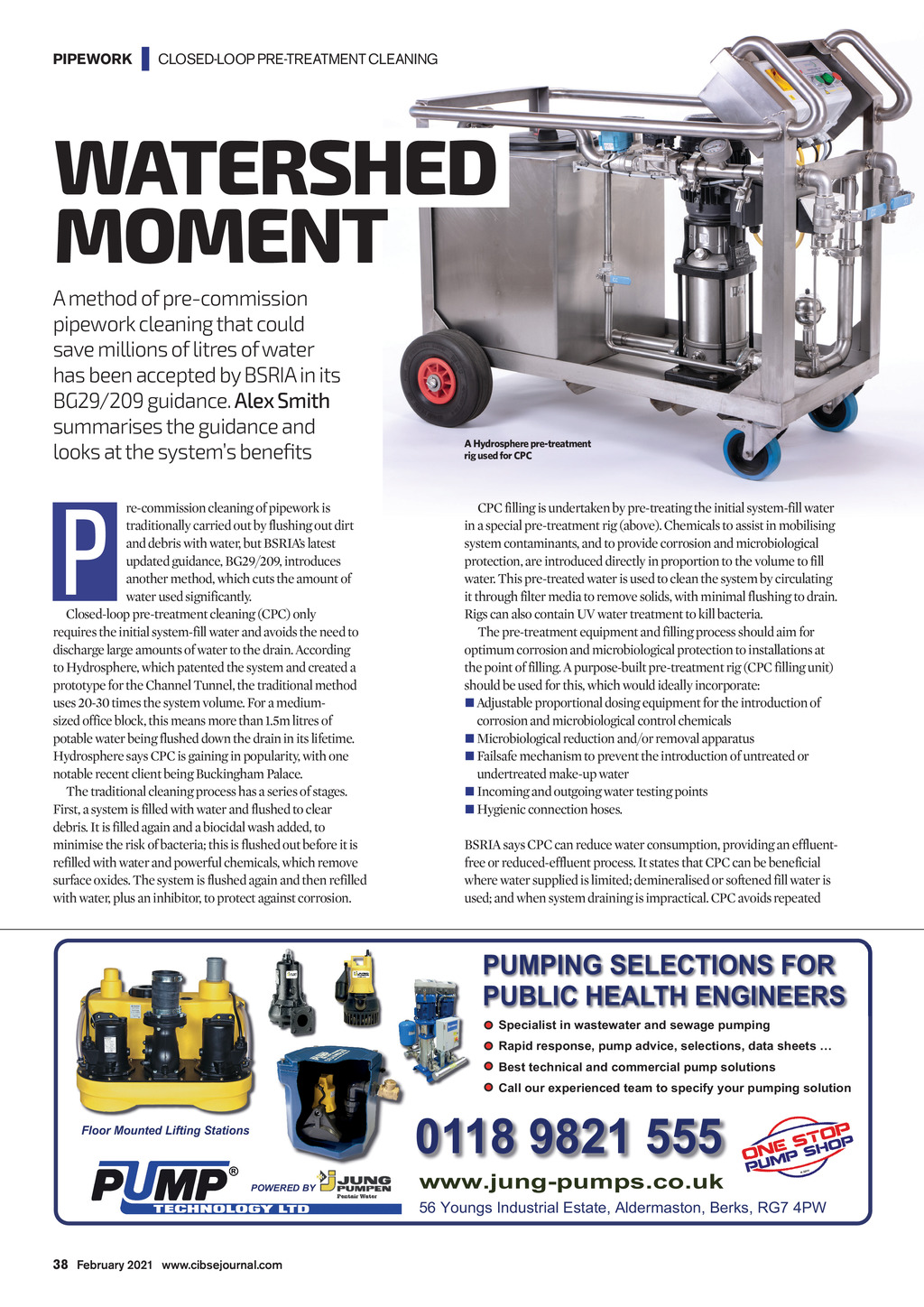




PIPEWORK | CLOSED-LOOP PRE-TREATMENT CLEANING WATERSHED MOMENT A method of pre-commission pipework cleaning that could save millions of litres of water has been accepted by BSRIA in its BG29/209 guidance. Alex Smith summarises the guidance and looks at the systems benefits P re-commission cleaning of pipework is traditionally carried out by flushing out dirt and debris with water, but BSRIAs latest updated guidance, BG29/209, introduces another method, which cuts the amount of water used significantly. Closed-loop pre-treatment cleaning (CPC) only requires the initial system-fill water and avoids the need to discharge large amounts of water to the drain. According to Hydrosphere, which patented the system and created a prototype for the Channel Tunnel, the traditional method uses 20-30 times the system volume. For a mediumsized office block, this means more than 1.5m litres of potable water being flushed down the drain in its lifetime. Hydrosphere says CPC is gaining in popularity, with one notable recent client being Buckingham Palace. The traditional cleaning process has a series of stages. First, a system is filled with water and flushed to clear debris. It is filled again and a biocidal wash added, to minimise the risk of bacteria; this is flushed out before it is refilled with water and powerful chemicals, which remove surface oxides. The system is flushed again and then refilled with water, plus an inhibitor, to protect against corrosion. A Hydrosphere pre-treatment rig used for CPC CPC filling is undertaken by pre-treating the initial system-fill water in a special pre-treatment rig (above). Chemicals to assist in mobilising system contaminants, and to provide corrosion and microbiological protection, are introduced directly in proportion to the volume to fill water. This pre-treated water is used to clean the system by circulating it through filter media to remove solids, with minimal flushing to drain. Rigs can also contain UV water treatment to kill bacteria. The pre-treatment equipment and filling process should aim for optimum corrosion and microbiological protection to installations at the point of filling. A purpose-built pre-treatment rig (CPC filling unit) should be used for this, which would ideally incorporate: Adjustable proportional dosing equipment for the introduction of corrosion and microbiological control chemicals Microbiological reduction and/or removal apparatus Failsafe mechanism to prevent the introduction of untreated or undertreated make-up water Incoming and outgoing water testing points Hygienic connection hoses. BSRIA says CPC can reduce water consumption, providing an effluentfree or reduced-effluent process. It states that CPC can be beneficial where water supplied is limited; demineralised or softened fill water is used; and when system draining is impractical. CPC avoids repeated 3803,1*6(/(&7,216)25 38%/,&+($/7+(1*,1((56 6SHFLDOLVWLQZDVWHZDWHUDQGVHZDJHSXPSLQJ 5DSLGUHVSRQVHSXPSDGYLFHVHOHFWLRQVGDWDVKHHWV %HVWWHFKQLFDODQGFRPPHUFLDOSXPSVROXWLRQV &DOORXUH[SHULHQFHGWHDPWRVSHFLI\\RXUSXPSLQJVROXWLRQ )ORRU0RXQWHG/LIWLQJ6WDWLRQV 32:(5( %< ZZZMXQJSXPSVFRXN